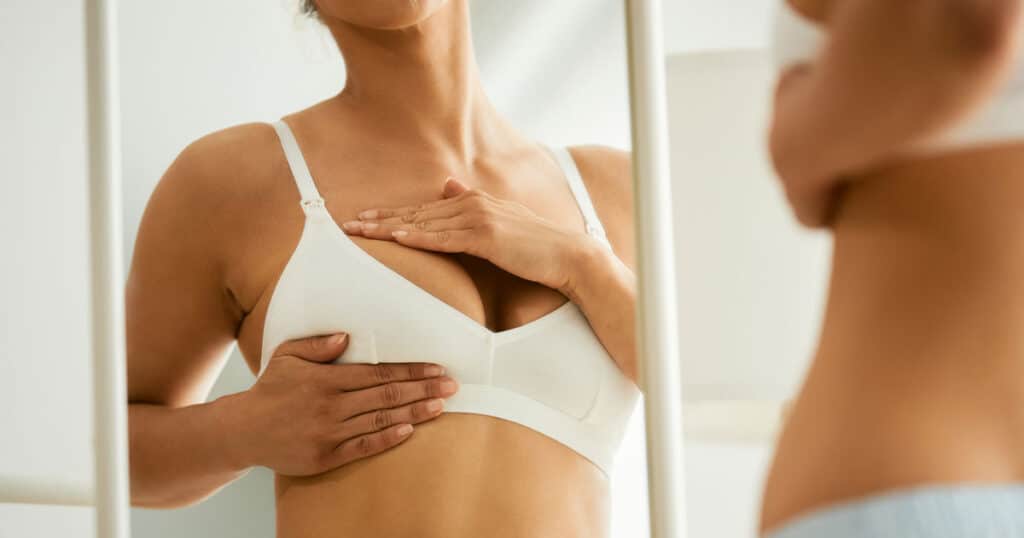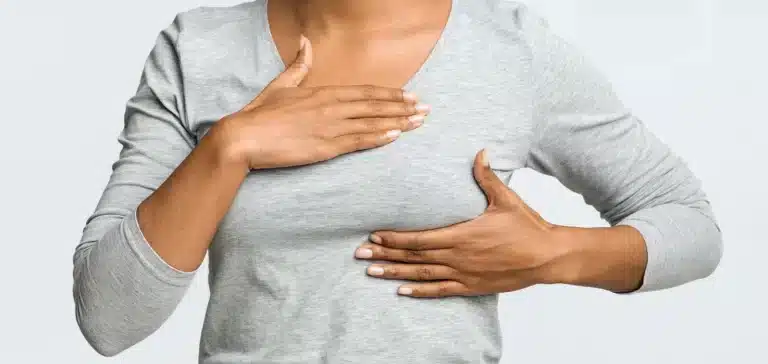It’s alarming to notice a red spot on your breast, especially if you’re unsure about its cause. While most red spots are harmless and result from common issues like bug bites, pimples, or allergic reactions, some may indicate serious conditions, including breast cancer. Understanding the causes, distinguishing signs, and when to seek medical advice is crucial for your health and peace of mind. This article delves into the various reasons for red spots on the breast, helping you recognize symptoms and take appropriate action.
Common Causes of Red Spots on the Breast

1. Bug Bites
Bug bites are among the most common causes of red spots on the breast. While harmless in most cases, they can cause discomfort.
- Appearance: Bug bites typically look like small, inflamed red bumps. They may appear in clusters or lines.
- Symptoms: Most bites are itchy and may cause mild swelling or pain. Some specific characteristics include:
- Flea bites: Tiny red bumps, often clustered in groups of three.
- Mosquito bites: Puffy, white, and red bumps that may itch intensely.
- Tick bites: Can form a distinctive bullseye-shaped rash if Lyme disease is transmitted.
- Treatment: Applying a cold compress or over-the-counter hydrocortisone cream can reduce itching and swelling. If the bite becomes infected or shows signs of spreading, seek medical attention.
2. Pimples and Acne
The skin on your breast, like anywhere else on your body, has sebaceous glands that can become clogged, leading to acne.
- Types:
- Whiteheads and Blackheads: Caused by clogged pores; whiteheads appear white, while blackheads look darker due to oxidation.
- Inflammatory Acne: Red, swollen pimples often caused by bacterial infections under the skin.
- Cystic Acne: Deep, pus-filled lesions that are painful and can last weeks.
- Causes: Hormonal fluctuations, oily skin, clogged pores, or bacterial buildup.
- Treatment: Maintain good hygiene and use non-comedogenic skincare products. Severe cases may require prescription medication.
3. Skin Irritations
Skin conditions such as rashes or irritations can also lead to red spots on the breast.
- Heat Rash: Tiny, red bumps that occur due to sweat trapped under the skin.
- Allergic Reactions: Exposure to irritants like perfumes, detergents, or fabrics can cause hives or redness.
- Atopic Dermatitis (Eczema): Red, scaly patches that itch or crust over.
4. Breast Infections
Breast infections are more common among breastfeeding women but can occur in others as well.
- Mastitis: A painful infection caused by bacteria entering milk ducts.
- Symptoms: Warmth, redness, and swelling, often accompanied by fever and flu-like symptoms.
- Breast Abscess: A pus-filled lump under the skin, typically caused by an untreated infection.
- Treatment: Antibiotics or surgical drainage may be required.
When a Red Spot Might Indicate Breast Cancer
While rare, some red spots on the breast can be an early sign of certain types of breast cancer. These conditions warrant immediate medical evaluation.
1. Inflammatory Breast Cancer (IBC)
IBC is a rare but aggressive form of breast cancer that affects the skin and lymph vessels.
- Symptoms:
- Redness and Swelling: The skin may appear inflamed or bruised.
- Texture Changes: Thickened, pitted skin resembling an orange peel (peau d’orange).
- Rapid Changes: The affected breast may become larger, heavier, or feel tender.
- Nipple Changes: Inversion, flattening, or unusual discharge.
- Prevalence: Accounts for 1–5% of all breast cancer cases. It progresses quickly and often involves lymph nodes by the time it is diagnosed.
2. Paget’s Disease of the Nipple
Paget’s disease is another rare form of breast cancer, affecting the nipple and surrounding areola.
- Symptoms:
- Lesions: Red, scaly, or crusted patches of skin, often mistaken for eczema.
- Pain or Itching: Persistent discomfort around the nipple.
- Nipple Discharge: Yellowish or bloody fluid may leak from the nipple.
- Nipple Deformation: Inversion or changes in the nipple’s appearance.
How to Differentiate Between Causes
It can be challenging to determine whether a red spot is harmless or requires medical attention. The table below highlights key differences between bug bites, pimples, and cancer-related symptoms.
| Feature | Bug Bite | Pimple | Breast Cancer (IBC or Paget’s) |
|---|---|---|---|
| Appearance | Small red bump; often itchy | Red or white bump, tender | Rash, thickened or pitted skin |
| Location | Anywhere on the breast | Anywhere on the breast | Often affects nipple or skin |
| Persistence | Resolves in days | Resolves in weeks | Worsens over time |
| Other Symptoms | Itching, mild swelling | Tenderness, redness | Nipple discharge, rapid changes |
When to See a Doctor
Early diagnosis is key to successful treatment, especially if the underlying cause is breast cancer. Seek medical advice if:
- The red spot or rash persists for more than two weeks.
- You notice additional symptoms like skin dimpling, nipple inversion, or discharge.
- There is significant swelling, pain, or warmth in the breast.
- You have a personal or family history of breast cancer.
Emergency Signs
Contact a healthcare professional immediately if you experience:
- A rash that spreads rapidly.
- Swollen lymph nodes in the neck or underarm.
- Fever or flu-like symptoms accompanying redness or swelling.
Diagnostic Procedures
If your doctor suspects something serious, they may perform the following tests:
- Physical Examination: To check for lumps or other abnormalities.
- Imaging Tests:
- Mammogram: X-ray imaging to detect abnormal tissue.
- Ultrasound: Uses sound waves to identify cysts or solid masses.
- Biopsy: A tissue sample is taken for detailed analysis.
- Blood Tests: To identify markers or infections.
Prevention and Self-Care Tips
Although not all red spots are preventable, there are steps you can take to reduce your risk of complications:
1. Breast Self-Awareness
- Perform monthly self-exams to familiarize yourself with the normal look and feel of your breasts.
- Look for changes in size, shape, or texture, and report anything unusual to your doctor.
2. Maintain a Healthy Lifestyle
- Diet: Eat a balanced diet rich in fruits, vegetables, and whole grains.
- Exercise: Aim for at least 30 minutes of moderate activity most days.
- Limit Alcohol: Excessive alcohol consumption is linked to a higher risk of breast cancer.
- Quit Smoking: Smoking has been associated with increased breast cancer risk.
3. Skincare Practices
- Use non-comedogenic products to avoid clogging pores.
- Keep the skin clean and dry to prevent infections or heat rashes.
4. Regular Medical Check-Ups
- Schedule annual mammograms starting at age 40, or earlier if you’re at high risk.
- Discuss any family history of breast or ovarian cancer with your doctor.
5. Genetic Counseling
- If you have a family history of breast cancer, consider genetic testing to evaluate your risk.
FAQs
1. What does a red spot on the breast mean?
Most commonly, it’s due to benign causes like pimples, bug bites, or allergic reactions. However, it can also be an early sign of rare cancers like inflammatory breast cancer or Paget’s disease.
2. How can I tell the difference between a pimple and breast cancer?
Pimples are typically superficial, tender, and resolve in weeks. Cancer-related spots often persist, worsen, and may be accompanied by other symptoms like skin dimpling or nipple discharge.
3. Can men develop red spots on their breasts?
Yes, men can develop red spots due to skin irritation or infections. Rarely, it could be a symptom of male breast cancer, which accounts for about 1% of all breast cancer cases.
4. Should I worry about a pimple on my breast?
While most pimples are harmless, monitor the spot. If it persists, grows, or is accompanied by other changes in the breast, consult a doctor.
Conclusion
A red spot on your breast is more likely to be a harmless issue like a pimple or bug bite than a sign of breast cancer. However, vigilance is essential. Monitoring your breasts for changes, knowing the warning signs of serious conditions, and seeking medical advice when needed can make a significant difference. Regular screenings and healthy lifestyle choices are vital for maintaining breast health and ensuring peace of mind. Always prioritize your well-being by addressing any concerns promptly with a healthcare professional.
References
Here are five concise references you can include at the end of your blog:
American Cancer Society – “Paget’s Disease of the Breast: Symptoms and Diagnosis.” Available at: cancer.org
WebMD – “Understanding Breast Rashes: Common Causes and When to Seek Help.” Available at: webmd.com
Healthline – “Red Spots on the Breast: Causes and Concerns.” Available at: healthline.com
MD Anderson Cancer Center – “Early Signs of Inflammatory Breast Cancer.” Available at: mdanderson.org
Cleveland Clinic – “Breast Rash: Symptoms, Causes, and Treatments.” Available at: clevelandclinic.org


